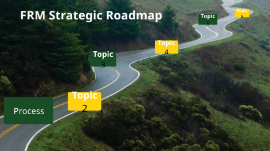Strategic Roadmap
Transcript: Future Review and Adjustment Plan A systematic review process must be established to assess the effectiveness of the roadmap, allowing for adjustments as necessary. Regular feedback loops and performance metrics will facilitate agile management and ensure alignment with evolving market conditions. Action Items for Stakeholders Conclusion and Next Steps Stakeholders should focus on implementing the defined strategic initiatives, monitor progress against the established milestones, and regularly communicate updates. Emphasis should be placed on accountability, collaboration, and leveraging resources effectively to ensure success. Summary of Key Takeaways This section encapsulates the vital takeaways from the strategic roadmap and outlines actionable steps for all stakeholders involved, ensuring continued progress and alignment with strategic goals. The strategic roadmap highlights the importance of aligning vision with actionable initiatives. Key takeaways include understanding market positioning, prioritizing strategic initiatives, and embracing a culture of continuous assessment to drive organizational growth. Roles and Responsibilities Clearly defined roles and responsibilities ensure that each team member understands their contribution to the implementation plan. It minimizes overlaps and gaps in efforts, enhancing collaboration and efficiency. A robust role assignment fosters a sense of ownership and encourages accountability across the project. Timeline and Milestones Establishing a timeline with key milestones enables the team to track progress effectively. Each milestone serves as a checkpoint to assess achievements, identify potential delays, and make necessary adjustments to stay on course. Consistent updates on the timeline foster accountability and transparency within the team. Monitoring and Evaluation Process Implementation Plan A robust monitoring and evaluation process is essential for assessing the implementation's effectiveness. Regular progress reviews, along with performance indicators, help identify success areas and areas requiring adjustment. Incorporating feedback loops fosters continuous improvement throughout the project lifecycle. An effective implementation plan crystallizes the strategy into actionable steps. By outlining timelines, assigning responsibilities, and establishing monitoring processes, organizations ensure alignment and accountability throughout the roadmap execution. Identifying Potential Risks Potential risks can arise from various sources including market changes, regulatory shifts, and internal operations. Early identification of risks allows organizations to assess their likelihood and impact, leading to more informed decision-making. Mitigation Strategies Navigating Risks Effectively Mitigation strategies involve specific actions aimed at reducing the impact or likelihood of identified risks. These can include diversifying product lines, enhancing regulatory compliance, and implementing training programs to prepare employees for changes. Resource Allocation Strategies Risk management is a critical component of strategic planning, enabling organizations to identify potential challenges and develop proactive responses to mitigate them. By understanding risks, businesses can ensure continuity and adapt to unexpected events. Strategic Initiatives Resource allocation strategies define how financial, human, and technological resources are distributed among initiatives. Effective allocation is crucial for project success, ensuring all areas are adequately supported to achieve optimal results. Contingency Planning Prioritization of Projects Contingency planning prepares organizations for unforeseen circumstances by outlining alternative actions in response to identified risks. Effective contingency plans detail roles, actions, and required resources to ensure swift response and recovery. Strategic initiatives are crucial components of the roadmap, guiding the organization toward its goals through well-defined projects. They establish a framework for prioritization and resource allocation, ensuring that all efforts align with strategic objectives. Project prioritization determines which initiatives receive focus and resources first. It utilizes criteria such as impact, feasibility, and alignment with strategic goals, creating a structured decision-making process to maximize return on investment. Initiative Development Initiative development involves identifying key projects that align with organizational goals. It requires evaluating market needs and organizational capabilities, transforming ideas into actionable plans that promote growth and innovation. Vision and Goals A clear vision and well-defined goals are crucial for guiding strategic initiatives. This section explores how an organization's vision informs its long-term objectives and the importance of aligning them with overarching organizational aims. Defining the Vision Alignment with Organizational Objectives

















